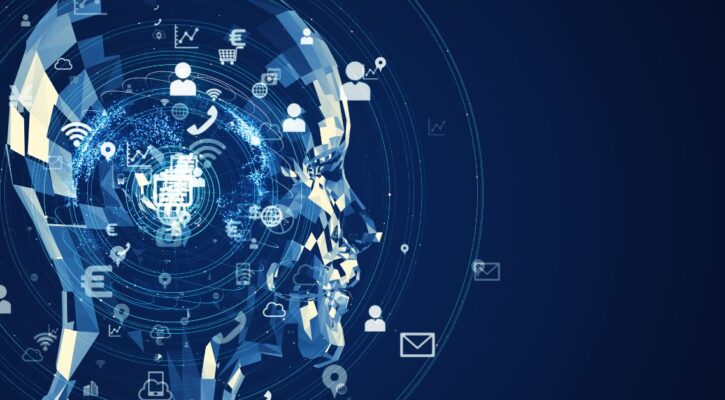Month: September 2023

AI and Cybersecurity: Safeguarding the Digital Realm
September 3, 2023
In an era dominated by digital interactions, the role of Artificial Intelligence (AI) in cybersecurity has become increasingly pivotal. This article delves into the intricate relationship between AI and cybersecurity, exploring how intelligent systems are evolving to detect threats, analyze risks, and defend against the ever-growing spectrum of cyber threats.
**1. Threat Detection Reinvented: AI’s Proactive Approach Uncover how AI is revolutionizing threat detection. This section explores the proactive capabilities of intelligent systems, which go beyond traditional rule-based methods. AI analyzes patterns, anomalies, and behavioral deviations to identify potential threats before they manifest. The shift towards AI-driven threat detection enhances the agility and responsiveness of V Circle.
The integration of AI in threat detection marks a paradigm shift from reactive to proactive cybersecurity, crucial in an era of constantly evolving cyber threats.
**2. Behavioral Analytics: Understanding the Human Element of Cybersecurity Delve into the role of behavioral analytics in cybersecurity powered by AI. This section examines how intelligent systems analyze user behavior, identifying deviations and anomalies that may signal potential security risks. By understanding the human element in cybersecurity, AI enhances the ability to distinguish between normal and malicious activities.
The incorporation of behavioral analytics adds a layer of sophistication to cybersecurity, enabling more accurate and context-aware threat detection.
**3. AI and Endpoint Security: Securing Every Digital Entry Point Explore how AI is fortifying endpoint security. This section delves into how intelligent systems analyze and protect every digital entry point, from individual devices to network endpoints. By continuously monitoring and responding to potential threats, AI-driven endpoint security ensures comprehensive protection in an increasingly interconnected digital landscape.
AI’s role in endpoint security extends beyond traditional antivirus measures, providing adaptive and real-time defense against a multitude of cyber threats.
**4. Risk Analysis and Mitigation: AI’s Predictive Insights Investigate how AI contributes to risk analysis and mitigation in cybersecurity. This section explores how intelligent systems leverage vast datasets to predict potential risks, assess vulnerabilities, and recommend mitigation strategies. AI’s predictive insights empower cybersecurity professionals to proactively address potential weaknesses before they are exploited.
The integration of AI in risk analysis transforms cybersecurity into a proactive and anticipatory defense system, minimizing the impact of potential cyber threats.
**5. Automated Incident Response: Speeding Up Cybersecurity Defense Delve into the role of AI in automating incident response. This section explores how intelligent systems can rapidly analyze and respond to security incidents, minimizing the time between threat detection and mitigation. The automation of incident response not only enhances the speed of cybersecurity defense but also frees up human resources for more strategic tasks.
AI’s contribution to automated incident response improves the efficiency and agility of cybersecurity operations, particularly crucial in the face of fast-evolving threats.
**6. AI and Threat Intelligence Sharing: Collaborative Defense Address the collaborative nature of cybersecurity defense facilitated by AI. This section examines how intelligent systems enable the sharing of threat intelligence across networks and organizations. By fostering collaboration, AI contributes to a collective defense strategy, ensuring that insights gained in one sector benefit the entire cybersecurity ecosystem.
The collaborative aspect of AI-driven threat intelligence sharing enhances the overall resilience of cybersecurity measures, creating a united front against cyber threats.
**7. Challenges and Ethical Considerations in AI-Cybersecurity Acknowledge the challenges and ethical considerations associated with the integration of AI in cybersecurity. This section explores issues such as algorithmic bias, transparency, and the potential misuse of intelligent systems. As AI becomes indispensable in cybersecurity, addressing these challenges is essential for responsible and effective defense strategies.
Ensuring the ethical deployment of AI in cybersecurity safeguards against unintended consequences and promotes a more secure and trustworthy digital environment.
Conclusion: Fortifying the Digital Frontier with AI-Cybersecurity As cyber threats continue to evolve in complexity, the synergy between AI and cybersecurity emerges as a linchpin in fortifying the digital frontier. From proactive threat detection to collaborative defense strategies, AI is instrumental in creating a resilient cybersecurity ecosystem. However, as we embrace the power of AI in safeguarding the digital realm, it is imperative to navigate the associated challenges with responsibility and ethics, ensuring a secure and trustworthy digital future.